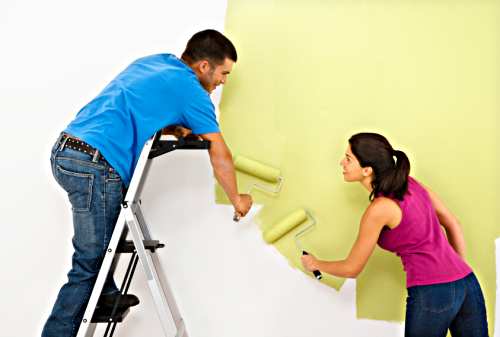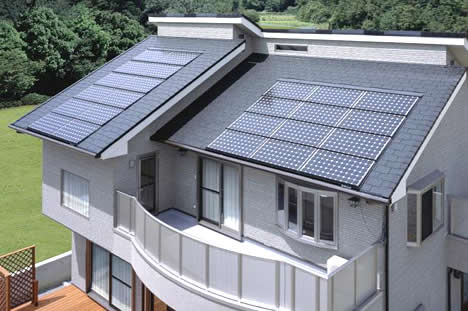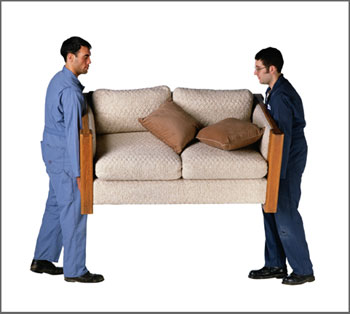
Easy & Affordable Home Improvement
|
 It is fairly
simple to change the atmosphere of your home with the addition of
accessories, from shelving to mirrors to lighting. Here are some
suggestions to
get you started: It is fairly
simple to change the atmosphere of your home with the addition of
accessories, from shelving to mirrors to lighting. Here are some
suggestions to
get you started:
- Simple is best in
most cases. Add a shelf
along one wall to display a few favorite photos, plants, decorative
soaps or
towels.
- Use an old low
dresser or vanity for a sink
base for extra storage. Refinish with paint washes or natural stains and
then
seal with a waterproof clear coat to protect the finish from moisture.
- Use your eclectic
collection of antique jars,
bowls or mugs to store/display collectibles, potpourri and small live
plants.
- Be creative by
adding non-traditional pieces,
like a wicker table or chair, if space allows.
- Try adding low
light fixtures or
"can" lights to give your rooms warmth.
- Consider decorative
tiles, stenciling or
textured plaster for your ceiling.
- Place mirrors
strategically around the room
to create a feeling of openness.
- Keep your eyes open
at thrift and second hand
stores for vases, watering cans, or window boxes for plants and flowers.
Add a
fabric or patterned covering to closet doors.
- For shelves,
consider a backdrop from
outdoor lattice panels and frame with wood trim.
- Give that front
door a new coat of paint,
door knob or knocker.
- Add a fresh coat of
paint to all your rooms.
This is one of the most affordable and easy ways to change the look and
feel of
your new home.
- Add light and airy
window treatments with an open weave
such as chiffon or organza.
- Revitalize cabinets
with a fresh coat of
paint or stain, or remove the doors and hardware for a truly
European-style
kitchen.
- Replace old
lighting fixtures and ceiling
fans. Sometimes just replacing the glass for the lights, or blades for
ceiling
fans gives rooms a whole new look without spending a lot.
Remember to
be eco-friendly by reusing items such as old furniture, frames, and
artwork. You
can make your own contribution to saving our planet - while saving
money. With
a little imagination and a bit of time, your old things will look fresh
and new
again.
|
|

Solar Energy – Costs and Benefits
|
|
 Incorporating
solar energy into your home will not only save you on your energy bill,
you'll
also reduce smog and CO² emissions by harnessing the sun into renewable
energy. Incorporating
solar energy into your home will not only save you on your energy bill,
you'll
also reduce smog and CO² emissions by harnessing the sun into renewable
energy.
Homeowners today are facing a steady rise in energy costs and the
reality of
global climate change. Transitioning power sources from fossil fuels to
renewable alternatives like wind and solar simply make the most sense in
the long
run. Solar power in most parts of the country can be effectively
incorporated
in several ways, however, there are initial costs to purchase and
install. The
savings for these changes will vary but most of the suggestions below
will pay
for themselves in a very short period of time and some require little
initial
investment, but make a large impact on energy use and savings.
Install
a
Solar Water Heater -
To upgrade from an existing water heater into a solar water heater,
costs range
from $4,000 to $6,000. Typically you'll spend less if you're building a
new
home. However, your water heating bills should drop 50%-80% after
installation.
That means you'll regain your investment in savings more quickly than
other
solar systems.
Consider
Skylights and Solar Tubes - Installing skylights for some may
be cost prohibitive,
but solar tubes are less expensive, provide natural light without
electricity,
and take up no more space than a normal light fixture.
Solar
Battery
Chargers - These
devices are cleverly incorporated into messenger bags, backpacks, and
roll-outs,
and provide renewing power for your cell phone, laptop, GPS, or portable
music
device.
Solar
Lights - These
are perhaps the most affordable and common solar products on the market.
Garden
and pathway lights come in a variety of styles for accents and safety
around
the home.
Solar
Screens or Curtains -
A very affordable way to regulate when and where you let the sun in.
During the
winter you can let the southern sun shine in to help keep your house
warm.
However, if windows aren't properly insulated, the cold breezes will
offset the
warmth. In the summer, lower the shades to lighten your air
conditioner's
burden, especially during the hottest part of the day.
|
|

First Time Home Buyers: What You Need to Know
|

Home
ownership is often referred to as the "American Dream", and our rate
of home ownership is the highest in the world: two out of three families
own
their own home. Buying a home is also the biggest financial investment
most
people make in their lifetime, so it makes sense to learn "and earn"
as much as possible.
The
basic benefits can be summarized as providing your need for shelter,
profit
potential, tax advantages and pride of ownership. It is commonly said
that even
when you rent, you pay a mortgage - your landlord's mortgage! So if you
need
shelter and can afford to buy a home, it makes economic sense to pay for
your
own mortgage instead of the landlord's. The tax advantages include
being able
to deduct the mortgage interest and property taxes from your income.
Uncle Sam
is very generous to homeowners.
Benefits of Homeownership
Owning
a home is considered a sign of success, and it provides great emotional
rewards
for many homeowners. It also provides an opportunity to improve an
investment
by upgrading the home and landscaping. And, unlike other investments
that are
based on the money invested, home ownership lets you obtain a return on
the
money you invested as well as money you borrowed. 'Leverage' is what
attracts
a potential buyer to real estate and rewards homeowners for living in and
improving
their homes. Real estate is a tangible asset, and over time once the economy recovers, your initial investment and improvements made over time will add to the value of your home.
Wants & Needs
Once
home buyers decide on the number of bed and bath rooms and settle on a
price
range based on their financial ability or their 'comfort zone' of
payments,
there are still a number of issues to ponder. What style of home is
appealing?
What kind of yard makes sense? How old should the home be and in what
kind of
condition? Is new construction the answer to your dream home ideas or do
you
love antique homes? What about a condominium? Take some time to
realistically
set criteria based on your present and future needs. Then make a list of
the
amenities or extras and identify if they are truly necessities. If not,
keep
a 'wish list' for the future.
|
|

Final Steps: Before You Move
|
 Regardless
of the amount of time you've lived in your home, it's likely you've had
memories
and experiences you'll want to remember, so for a lot of people, moving
from
your current house is like saying goodbye to an old friend. Regardless
of the amount of time you've lived in your home, it's likely you've had
memories
and experiences you'll want to remember, so for a lot of people, moving
from
your current house is like saying goodbye to an old friend.
1. Defrost your
refrigerator and freezer.
2. Gather all your
important documents, keys, maps, etc., and place in a prominent area for
the
move.
3. Pack up a box of
items you'll need immediately when you get to your new place - like your
coffee
maker, coffee, tea, cups, dish towels, cleaning supplies, paper towels,
toilet
paper, and cleaning sponges.
4. Begin disassembling the
last pieces of furniture, including the beds.
5. Call your bank,
utility companies and switch service addresses, update or change
telephone
numbers, and schedule installation of cable or satellite service.
6. Pack up your computer
and all peripherals.
Arrange
for pet sitting on the day or days of your move to ensure the safety and
security of your furry friends. If you are moving to another city or
state, make
sure you have leashes, cage, water, and food dishes ready to go.
|
|
|
|

Contact me:
|
|

Home Remodeling Safety Tips
|
|
Being
your own home improvement specialist can bring a measurable feeling of
pride
and success. However, if you are not prepared for each job with the
correct
tools, it could also mean a trip to the emergency room! Here are some common sense
tips for the jobs you are
planning.
Use the right tool for the job. It may be tempting to use the
end of your screwdriver to tap in a nail, or to pry something apart. Not
a good
idea. You may not only damage the tool, but it could slip or break at
the wrong
time and damage you too. When planning your project, do some research
for the
tools you will need. Internet sites or books devoted to do-it-yourself
projects
will offer a list of supplies and tools needed to complete these tasks
efficiently and safely.
While shopping for the right tools, plan on purchasing safety equipment
like
goggles, gloves, guards, and dust masks. Goggles should be worn during
most of
your tasks to make sure that dust or chips from sawing or drilling are
deflected away from your eyes. You will need gloves to protect your
hands from
sharp edges, splinters, and rough surfaces, as well as from paint and
harsh
chemicals. Again, look for quality at reasonable prices.
|
|

How to Repair Drywall
|
|
Patching holes in drywall is a simple
process, so save yourself from hiring someone to do it for you. You
don't even have to
buy an expensive drywall kit from a home improvement store. All you'll
need is:
- one tub of joint
compound
- a plastic or metal
spackle knife
- light grade
sandpaper
1. Using your putty knife, gently go over the hole that needs to be
patched.
This will smooth out the surface, cleaning up the area so it's ready for
spackling.
2. Next, scoop out some joint compound with your putty knife and spread
it over
the hole. Don't worry about any excess compound that remains... you'll
deal
with it later.
3. Let the compound dry for 24 hours.
4. Using either sandpaper or a sanding block, sand the area until
smooth.
5. Lastly, paint over the now smooth repaired drywall, to match the rest
of the
wall.
|
|

Mortgage Calculator- How Much Home Can
You Afford?
|
|
The
first step in shopping for a home should be determining how much home
you can
afford. The general rule is that the payments on your new home
shouldn't
account for more than 30 percent of your overall income.
Your income,
credit rating, current monthly expenses, down payment, and the interest
rate
will determine the final total that you will be able to afford. If
needed, find
a housing counselor who can help you figure out how to manage and pay
down or
pay off existing debt, and give you a solid foundation of information
for your
plan.
The
amount you pay for a home is based on several factors. You are the best
judge
of what you can comfortably pay every month. Take some time to calculate
all
your expenses - to include what you spend daily on lunches, coffee,
transportation, and other costs that otherwise go unnoticed. Then add in
local
property taxes and anticipated maintenance of your home, or other
improvements/additions that may be necessary in the near future.
Lending institutions use the following criteria to calculate
what size loan you
are qualified for. The three main things they look at are: 1) Your
monthly
payments as a percentage to your income; 2) How much cash you have for
the down
payment and closing costs; and 3) Your credit rating.
|
|
|
|
